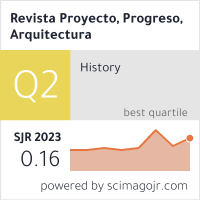HOMO (PRE) FABER / Homo (pre)faber
DOI:
https://doi.org/10.12795/ppa.2012.i6.11Palabras clave:
prefabricación, vivienda, arte, homo faber, técnica, tecnología, habitar / prefabrication, housing, art, craftmanship, technology, livingResumen
RESUMEN En el presente número de la Revista PpA, dedicado a la vivienda prefabricada, se entrelazan dos de los campos de investigación de la arquitectura más efervescentes del último siglo: técnica y habitar. Industrialización, estandarización, modulación y seriación se confunden con el concepto de prefabricación como finas capas de un hojaldre difíciles de separar, horneadas bajo un mismo fuego que no es otro que el de responder a través de la producción reglada al alojamiento. En todos estos términos, el valor de la técnica, donde la figura del artesano aún permite pensar en una respuesta específica para cada producto, virará hacia el de la tecnología, dificultando incluir el hecho particular dentro del proceso creativo. Esta confrontación entre objetividad y contingencia adquiere mayor relevancia en el caso de la vivienda prefabricada, por la distancia especulativa que implica la ultimación del diseño previo a su construcción. La actual proliferación de soluciones predefinidas a la hora de enfrentarse al proyecto arquitectónico –principalmente en aspectos constructivos– y el aumento de la producción prefabricada de viviendas a nivel mundial requieren una reflexión disciplinar en la materia, que hilvane relaciones intencionadas entre hombre y producto.
SUMMARY This issue of PPA is dedicated to the prefabricated home, and intertwines two of the most lively research areas in architecture over the last century: craftsmanship and living. Industrialization, standardization, modularization and serial production become blended with the concept of prefabrication as thin layers of puff pastry, difficult to separate, baked under the same fire which is nothing more than responding to accommodation needs through regulated production. In all these terms, the value of craftsmanship, where the artisan is still allowed to think of a specific response for each product, will veer towards that of technology, making the inclusion of that response in the creative process more difficult. This confrontation between objectivity and contingency becomes more important in the case of the prefabricated home, due to the speculative distance involved in the finalization of the design, prior to its construction. The current proliferation of predefined solutions that are available for tackling the architectural project, mainly in construction aspects, and the increased prefabricated production of homes worldwide require a disciplinary reflection on the subject, which tacks together the intended relationships between man and product.
Descargas
Descargas
Publicado
Cómo citar
Número
Sección
Licencia
Las ediciones impresa y electrónica de esta Revista son editadas por el Secretariado de Publicaciones de la Universidad de Sevilla, siendo necesario citar la procedencia en cualquier reproducción parcial o total.
Salvo indicación contraria, todos los contenidos de la edición electrónica se distribuyen bajo una licencia de uso y distribución “Creative Commons Atribución-NoComercial-SinDerivar 4.0 Internacional” ![]() . Puede consultar desde aquí la versión informativa y el texto legal de la licencia. Esta circunstancia ha de hacerse constar expresamente de esta forma cuando sea necesario.
. Puede consultar desde aquí la versión informativa y el texto legal de la licencia. Esta circunstancia ha de hacerse constar expresamente de esta forma cuando sea necesario.
Los autores/as que publiquen en esta revista aceptan las siguientes condiciones:
- Los autores/as conservan los derechos de autor y ceden a la revista el derecho de la primera publicación, con el trabajo registrado con la licencia de atribución de Creative Commons, que permite a terceros utilizar lo publicado siempre que mencionen la autoría del trabajo y a la primera publicación en esta revista.
- Los autores/as pueden realizar otros acuerdos contractuales independientes y adicionales para la distribución no exclusiva de la versión del artículo publicado en esta revista (p. ej., incluirlo en un repositorio institucional o publicarlo en un libro) siempre que indiquen claramente que el trabajo se publicó por primera vez en esta revista.
- Se permite y recomienda a los autores/as a publicar su trabajo en Internet (por ejemplo en páginas institucionales o personales) antes y durante el proceso de revisión y publicación, ya que puede conducir a intercambios productivos y a una mayor y más rápida difusión del trabajo publicado (vea The Effect of Open Access).









